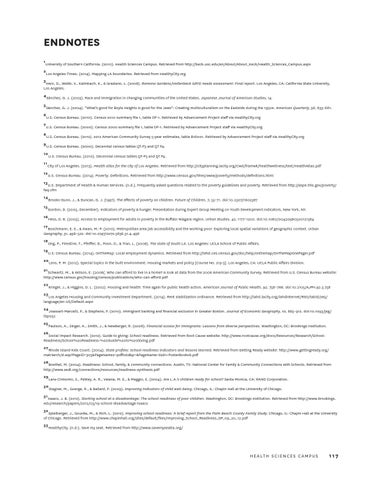ENDNOTES 1
University of Southern California. (2010). Health Sciences Campus. Retrieved from http://keck.usc.edu/en/About/About_Keck/Health_Sciences_Campus.aspx
2
Los Angeles Times. (2014). Mapping LA boundaries. Retrieved from HealthyCity.org
3
Herz, D., Webb, V., Kalmbach, K., & Graziano, L. (2008). Ramona Gardens/Hollenbeck GRYD needs assessment: Final report. Los Angeles, CA: California State University, Los Angeles. 4 5 6 7 8 9
Sánchez, G. J. (2003). Race and immigration in changing communities of the United States. Japanese Journal of American Studies, 14. Sánchez, G. J. (2004). “What’s good for Boyle Heights is good for the Jews”: Creating multiculturalism on the Eastside during the 1950s. American Quarterly, 56, 633–661. U.S. Census Bureau. (2010). Census 2010 summary file 1, table DP-1. Retrieved by Advancement Project staff via HealthyCity.org U.S. Census Bureau. (2000). Census 2000 summary file 1, table DP-1. Retrieved by Advancement Project staff via HealthyCity.org U.S. Census Bureau. (2012). 2012 American Community Survey 5-year estimates, table B16001. Retrieved by Advancement Project staff via HealthyCity.org U.S. Census Bureau. (2000). Decennial census tables QT-P3 and QT P4.
10 11
U.S. Census Bureau. (2010). Decennial census tables QT-P3 and QT P4.
City of Los Angeles. (2013). Health atlas for the city of Los Angeles. Retrieved from http://cityplanning.lacity.org/Cwd/framwk/healthwellness/text/HealthAtlas.pdf
12
U.S. Census Bureau. (2014). Poverty: Definitions. Retrieved from http://www.census.gov/hhes/www/poverty/methods/definitions.html
13
U.S. Department of Health & Human Services. (n.d.). Frequently asked questions related to the poverty guidelines and poverty. Retrieved from http://aspe.hhs.gov/poverty/ faq.cfm
14 15
Brooks-Gunn, J., & Duncan, G. J. (1997). The effects of poverty on children. Future of Children, 7, 55–71. doi:10.2307/1602387 Gordon, D. (2005, December). Indicators of poverty & hunger. Presentation during Expert Group Meeting on Youth Development Indicators, New York, NY.
16
Hess, D. B. (2005). Access to employment for adults in poverty in the Buffalo-Niagara region. Urban Studies, 42, 1177–1200. doi:10.1080/00420980500121384
17
Boschmann, E. E., & Kwan, M.-P. (2010). Metropolitan area job accessibility and the working poor: Exploring local spatial variations of geographic context. Urban Geography, 31, 498–522. doi:10.2747/0272-3638.31.4.498
18 19
Ong, P., Firestine, T., Pfeiffer, D., Poon, O., & Tran, L. (2008). The state of South LA. Los Angeles: UCLA School of Public Affairs. U.S. Census Bureau. (2014). OnTheMap: Local employment dynamics. Retrieved from http://lehd.ces.census.gov/doc/help/onthemap/OnTheMapOnePager.pdf
20
Lens, P. M. (2012). Special topics in the built environment: Housing markets and policy [Course No. 219-3]. Los Angeles, CA: UCLA Public Affairs Division.
21
Schwartz, M., & Wilson, E. (2008(. Who can afford to live in a home? A look at data from the 2006 American Community Survey. Retrieved from U.S. Census Bureau website: http://www.census.gov/housing/census/publications/who-can-afford.pdf
22
Krieger, J., & Higgins, D. L. (2002). Housing and health: Time again for public health action. American Journal of Public Health, 92, 758–768. doi:10.2105/AJPH.92.5.758
23
Los Angeles Housing and Community Investment Department. (2014). Rent stabilization ordinance. Retrieved from http://lahd.lacity.org/lahdinternet/RSO/tabid/263/ language/en-US/Default.aspx
24
Joassart-Marcelli, P., & Stephens, P. (2010). Immigrant banking and financial exclusion in Greater Boston. Journal of Economic Geography, 10, 883–912. doi:10.1093/jeg/ lbp052
25
Paulson, A., Singer, A., Smith, J., & Newberger, R. (2006). Financial access for immigrants: Lessons from diverse perspectives. Washington, DC: Brookings Institution.
26
Social Impact Research. (2012). Guide to giving: School readiness. Retrieved from Root Cause website: http://www.rootcause.org/docs/Resources/Research/SchoolReadiness/School%20Readiness-%20Guide%20to%20Giving.pdf
27
Rhode Island Kids Count. (2004). State profiles: School readiness indicators and lessons learned. Retrieved from Getting Ready website: http://www.gettingready.org/ matriarch/d.asp?PageID=303&PageName2=pdfhold&p=&PageName=6281+PosterBookv8.pdf
28
Boethel, M. (2004). Readiness: School, family, & community connections. Austin, TX: National Center for Family & Community Connections with Schools. Retrieved from http://www.sedl.org/connections/resources/readiness-synthesis.pdf
29
Lara-Cinisomo, S., Pebley, A. R., Vaiana, M. E., & Maggio, E. (2004). Are L.A.’s children ready for school? Santa Monica, CA: RAND Corporation.
30
Stagner, M., Goerge, R., & Ballard, P. (2009). Improving indicators of child well-being. Chicago, IL: Chapin Hall at the University of Chicago.
31
Isaacs, J. B. (2012). Starting school at a disadvantage: The school readiness of poor children. Washington, DC: Brookings Institution. Retrieved from http://www.brookings. edu/research/papers/2012/03/19-school-disadvantage-isaacs
32
Spielberger, J., Gouvêa, M., & Rich, L. (2012). Improving school readiness: A brief report from the Palm Beach County Family Study. Chicago, IL: Chapin Hall at the University of Chicago. Retrieved from http://www.chapinhall.org/sites/default/files/Improving_School_Readiness_DP_09_20_12.pdf
33
HealthyCity. (n.d.). Save my seat. Retrieved from http://www.savemyseatla.org/
usc_son_hsc_1e.indd 117
H E A LT H S C I E N C E S C A M P US
117
4/6/15 7:20 PM
